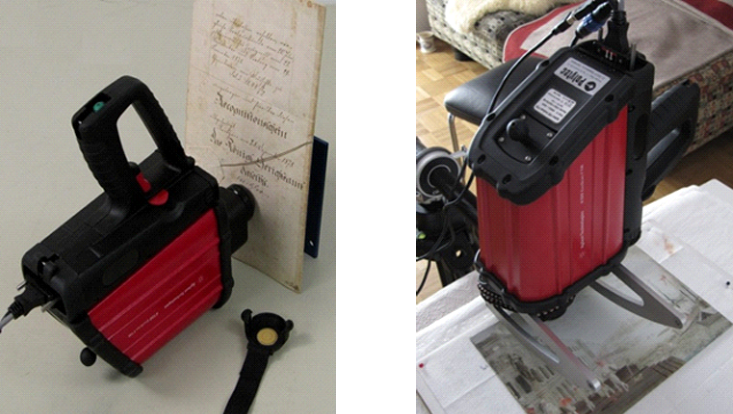FTIR-Spectrometer (DRIFTS, ATR); Agilent ExoScan 4100

CSMC
For FTIR spectroscopy, a method used over the last 80 years, samples were usually measured in transition mode, which means that small samples had to be taken from an object. Recently, non-destructive methods have been developed to study the surfaces of different objects. The miniaturisation of IR sources and detectors has enabled the development of a new generation of portable spectrometers that allow handheld investigation in a diffuse reflection mode (e.g., A2 Technologies). We use the ExoScan to analyse especially organic material and some inorganic pigments, filler materials and degradation products. During the measurement, it is also possible to fix the spectrometer on a tripod, to a table or to a stand.
- General description: Chemical analysis (FTIR in diffuse reflection or Ge crystal attenuated total reflection) of mostly organic materials and some inorganic pigments, filler materials and degradation products.
- Application aim: Molecular analysis of organic and inorganic materials, in particular pigments and dyes, binders, fillers and sizing agents.
- Mobility: mobile; 1 box of 3.5 kg + tripod, table or stand
- Equipment specifics:
- Spectral resolution: 4 cm-1
- Spectral range: 4000 to 650 cm-1
- Spatial resolution of 10 mm
- Detector: thermoelectrically-cooled dTGS
- Laser: low powered solid state, source: wire wound element
- Dock station
- DRIFTS head, equipment specifics: gold reference cup;
- sample required: no; contact required: yes;
- interaction spot dimensions: 1 cm diameter measuring spot;
- limitations: surface analysis; instrument on table or tripod; if the contact is unstable, it results in noisy spectra.
- ATR head, equipment specifics: germanium crystal, sample press;
- sample required: no if object thinner than 3 cm, otherwise yes: c. 0.5 g powder;
- contact required: yes, the sample press leaves a dent in the sample (invasive analysis);
- interaction spot dimensions: 2 mm diameter and 2-5 μm depth of penetration
- limitations: surface analysis; instrument in the docking station
- Application requirements: T=0-50 °C; RH < 95%, power supply
- Sample required: no
- Contact required: yes
- Set up time: 40 min including warm-up
- Average time for measuring: depending on the number of scans/measure: average 5-10 minutes; minimum 32 scans are needed, better 128 or 256
- Average time for processing: depends on the complexity of the spectra (between few minutes to one hour)
- Software package: MicroLab PC
- Output: Data Size and Data Format
- Evaluation program: Omnic or Origin
- Contact: Sebastian Bosch, sebastian.bosch"AT"uni-hamburg.de
- Location of the equipment: CSMC Lab (Warburgstr. 28, Hamburg)
